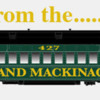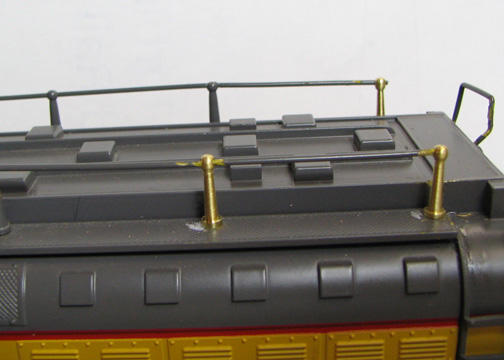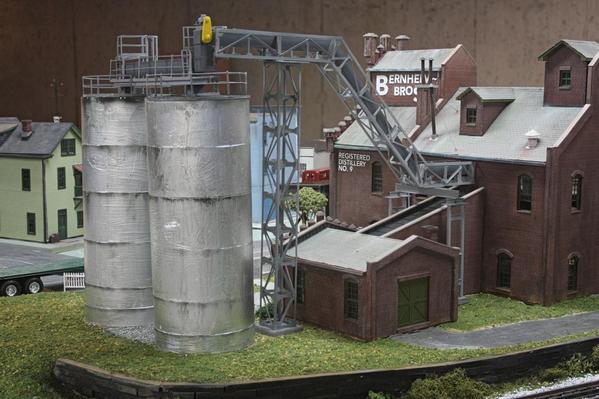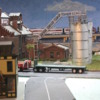Thanks 86TA... I really appreciated the thoughts.
The YT thoughts are intriguing, but how many more railroad modelers do I need to link with. I already have a gaggle of railroad modelers with whom I am in regular contact. I have some concerns about the actual videoing when I'm doing it alone. I'd love to build a series about doing some of the more sophisticated crafting skills that I've developed and taught over the decades. I also would require a much cleaner and orderly shop space. I am dedicated to advancing this hobby and especially attracting new (and younger) blood.
As I predicted, the Scultamold was not fully dry in the thickest sections so I left it alone for the day. We had about 3" of snow today so winter is officially upon us here in the central Ohio Valley. What a great day to be in the shop building models!
And now for something completely different.
I built this model when it was originally produced (in 1956) when I was 11 and building models like a maniac. I built a model a week for several years. My parents were very understanding. Anyway... it's the Revell White Gas Truck. It's actually 1:48 so it's a must-have for a model railroad. There are very few trucks out there that are actually our scale. I found it at Scale Reproductions a couple of weeks ago. Some guy turned it in on a trade and the price was right so I impulsively bought it. It's a re-issue, but produced with the old dies (and it shows it), having lots of flash and some sink holes. My modeling skills are so far advanced from when I was 11 that it will make a nice build.

My service station is Sinclair so I'm thinking about painting the truck green and creating my own Sinclair decals. I have some left over decals from the Berkshire Valley gas station build a couple of years ago, but they're too small. I bought Inkjet decal film and haven't had a chance to try it out yet. So I'm going to scan the decals I have and enlarge them to the size that fits the truck's tank. The level of sophistication of today's slide-molded plastic kits is so outstanding and beyond what was produced in 1956 that the kit provides some challenges. For example: the kit has no provisions for window glazing so I'm adding it out of 0.010" clear styrene.
To do the best job so seam fitting/filling and painting, I'm constructing a lot of the model before doing the color change. This will create a lot of post-airbrush hand painting.
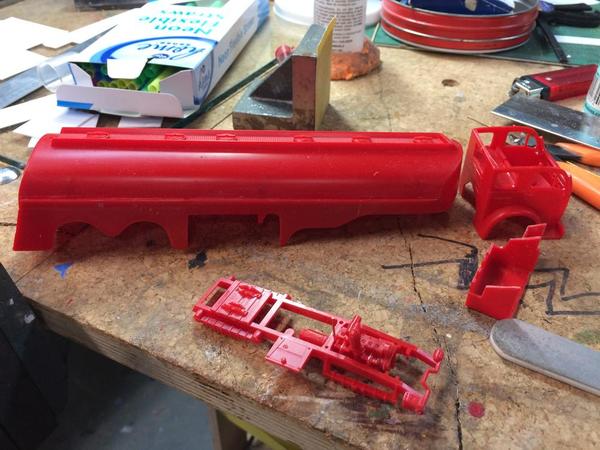
The kit's part count is low by today's standards, but that's okay since I'm really not interested in a serious plastic build. The engine depicts a flat-head six. Wheels and tires are one-piece red plastic, again making for challenging painting since I'm painting the rims Sinclair green.
To fit the windshield, I glued together all the cab parts except the roof, then taped the roof in place. I can't glue the roof in until the interior is painted. Unlike later car kits where the body and interior are separate and can be painted and detailed before assembly, in this instance, the seats form a structural part of the cab and need to go in to hold the sides of the cab in place. The lower front is separate as is the roof. I first tried tracing the windshield's shape onto white paper, but I was getting an inaccurate result. I then turned to Tamiya masking tape which would hold itself in place while I traced the windshield's shape. This worked well.

I stuck the tape onto the styrene and cut out the shape with a pair of Fisker's scissors. I cut it oversized and then crept up to the actual shape. Here's the resulting glazing waiting until all the paint work is done to go in. I will probably use Hypo-glue to hold it in place. It's a cement that has a fine capillary tube applicator and gives excellent control for glazing. The side and back windows glue to flat surfaces didn't require custom fitting like the front did.
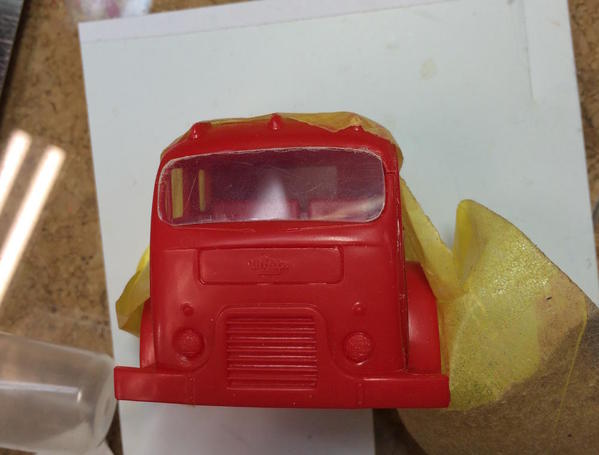
There's a couple of nasty joints at the front pillars that will need attention. I'm going to use Bare Metal Foil for the wipers, head lights and other trim.
I gave Andre the green light to cut the boiler house. I'll have it in a couple of weeks. In the interim, I'll maybe make some more telephone poles, finish the gas truck, landscape the distillery, and start thinking about other things. Walther's had the Plastruct Chemical Plant kit on sale over the holidays. I really want one of those for the back side of the layout, and will probably spring for it later this year. I also am committed to building the distillery for Heaven Hill's visitor center. Incidentally, they just announced a $15 million expansion for the modern Bernheim distillery here is Southwest Louisville. Bourbon is doing very well indeed. Andre's giving me pricing for all the distillery parts as subassemblies in case any of you folks would like to have it, but not go for the whole shebang at one go.
At some point I'm going to have to bite the bullet and get working on the layout's right end. It's where the tunnel and mine are going and I'm procrastinating about it. I tend to do that when I not sure about the approach I'm taking. Unlike the bridges which were needed to make the railroad function, the tunnel is strictly cosmetic. AND I need to build that 17 foot long facing wall below the high line. That's another thing about which I'm procrastinating. Luckily, I'm my own boss, the trains are running well, it's a lifelong hobby, and I'm retired.







